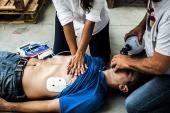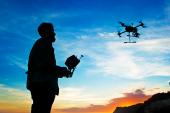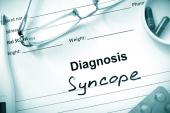Sit Back, Relax . . . and Respond to an In-flight Medical Emergency?
Several ACC attendees heading home from the meeting had to help out with medical emergencies at cruising altitude.

Under her dim overhead light, Heba Wassif, MD (Cleveland Clinic, OH), was catching up on paperwork amid rows of sleepy passengers on her flight from Washington, DC, to Cairo, Egypt, after the American College of Cardiology (ACC) 2022 Scientific Session when a voice startled her out of her seat.
“It was 3 hours ahead of our arrival and I hear the flight attendant say, ‘Sir, are you okay? Are you okay?’” she recalled to TCTMD. “You just jump up and say, ‘Okay, there's something going on.’ And within a few seconds, they ask if there's a doctor on flight.”
Hurrying over, she found an 87-year-old man unresponsive with no pulse. Within moments, two other cardiologists who had also been at the ACC meeting came to help, as well. They reclined the man’s seat as much as possible and started CPR.
“We kept feeling the pulse, and then finally the pulse came back,” Wassif said, adding that the automated external defibrillator (AED) did not find a shockable rhythm. She believes the man had likely experienced a vasovagal syncope episode and bradycardia, where his heart rate slowed to a halt. Quick CPR “is probably what saved this man's life,” Wassif said. What struck her at the time was how “daunting” it would have felt if she’d needed to recommend the full flight be diverted, but ultimately, they were able to continue on as planned.
If you were in the hospital, you'd be running. Heba Wassif
Halfway around the globe, another ACC attendee, Cher Hagaman, NP (VA Long Beach Healthcare System, CA), also assisted with an apparent cardiac emergency on her flight home following the meeting. She’d walked to the back of the plane to use the restroom and noticed a man in his late 50s or early 60s making his way along the aisle.
“He was walking kind of wobbly, but there was some turbulence, so I didn't think anything of that,” said Hagaman, a critical care cardiology nurse by training. “Then he put his hand up against the wall to steady himself, and I could see in his eyes that something was wrong.”
Moments later, Hagaman managed to attract the attention of a flight attendant in time to help her catch the man as he fell. They were able to safely lower him to the ground and lift his legs to restore blood flow and consciousness. Helping him to a seat, a family practice physician came to take a verbal history. Hagaman, meanwhile, took his blood pressure and pulse oximeter reading using tools from the flight’s emergency kit. “They gave me the most terrible stethoscope in the world,” she recalled, laughing, “It was like a plastic one you'd give to a child.”
The patient’s blood pressure returned to normal and his pulse was regular, but his core temperature was very high. Hagaman’s best guess: “He just vagaled. He got too hot. He hadn't been drinking or eating. This happens all the time on a plane, where people don't want to keep getting up and disturbing everybody so they don't eat or drink enough.”
The physician recommended the man see his doctor for a full workup after landing, Hagaman said, “But it definitely disrupted the flight. People were freaking out.”
‘Why Me?’
In-flight medical emergencies (IMEs) occur in about one in every 604 commercial flights, according to a 2018 review article in the JAMA. This would be equivalent to 260-1,420 events every day worldwide. Syncope or near syncope make up nearly one-third of these events, while gastrointestinal (14.8%), respiratory (10.1%), and cardiovascular symptoms (7.0%) are the other most common IMEs. A 2013 study, published in the New England Journal of Medicine, found that medical personnel help in about three-quarters of IMEs—48.1% of the time it was physicians responding—and aircraft diversion happened in 7.3%.
Richard Kovacs, MD (Indiana University School of Medicine, Indianapolis), chief medical officer of the ACC, told TCTMD he has assisted on IMEs “many times” over the years and happily they’ve all been mild or resolvable cases. But the first thought that comes to mind when hearing a call for medical assistance on a plane, he admitted, is: “Why me?”
The hardest part is “the uncertainty of responding to any cardiac emergency layered on with the fact that you realize that you have no idea of what you're going to be facing, and that you have very limited resources available to you, and you have no space,” he explained.
The COVID-19 pandemic has also obviously changed a lot about air travel, making the precise numbers less certain, but Kovacs said it hasn’t altered how he approaches IMEs. “It's the same as always,” he said. “We deal with uncertainty, [since] we don't know what communicable diseases people on airplanes might have. COVID makes us more aware, but it's still patient first.”
You'd be surprised how much you know and how much you can help. Cher Hagaman
In the US, the Federal Aviation Administration (FAA) requires that, at a minimum, all commercial flights carry an emergency medical kit that includes an AED; tools to aid in basic assessment, bleeding control, and starting an IV; and a variety of medications including analgesics, antihistamine, atropine, epinephrine, and nitroglycerin. US flight attendants are also required to undergo training in CPR every 24 months. Rules in other countries vary, however, as do required tools and training.
Christian Martin-Gill, MD (University of Pittsburgh Medical Center, PA), who co-authored both the JAMA and NEJM articles, said he wants clinicians to be assured that “the majority of in-flight emergencies can be handled safely with the medical equipment that's on board and by the personnel that are there.”
Resources for IMEs
Martin-Gill works with STAT-MD, a physician-based ground consultation service run out of his institution that contracts with five major US-based airlines to provide real-time support for IMEs. On average, the service offers aid to 20,000 IMEs each year. But many clinicians, he said, aren’t aware that this support exists and might be reassured to learn that they won’t be flying solo, so to speak, if they’re summoned to help during a flight.
“The benefit for airlines of contacting a ground-based medical support service is that we have the experience of handling tens of thousands of similar emergencies,” he said. “We can provide guidance, not only in what the contents of the on-board medical kit are, but also take into consideration operational things [like considering when to divert a flight].
“On most occasions, that communication happens in the cockpit and you may not know about it if you're standing in the back with a passenger who's ill,” Martin-Gill continued. “But certainly if it doesn't happen, regardless of the airline, I would engage the flight crew to engage that support team on the ground so that you have a whole team involved.”Wassif said she was not aware of any ground medical support, except for the fact that there was an ambulance waiting for the passenger when they landed in Cairo. And while the Egyptair medical kit had “much more than I expected,” she said the medicines weren’t properly labeled and “difficult to identify.”
Hagaman also said she was not aware of the existence of ground medical support, but said it was likely not warranted in this situation since the patient recovered quickly. Other than the toy-like stethoscope, she said the medical kit on board her plane was adequate, especially since it included a pulse oximeter, which is not legally mandated. “That was super helpful,” Hagaman said, for ascertaining right away whether oxygen levels were normal. Moreover, supplemental oxygen was available on the plane, “so if his pulse ox had been low, we would have started oxygen,” she added.
Martin-Gill said it is rare for airplane medical kits to be missing any components or be mislabeled, at least in the US, “because it's an FAA requirement. . . . Just like any piece of required equipment for an aircraft, airlines take that very seriously.” However, international airlines will often have medications labeled with different names or perhaps not in English, he warned. “We have to be facile in being able to look up a medication we're not used to because it's not a name that we use in the United States.”
Given the frequency of IMEs, some physicians might want to board with some tricks up their sleeves. Kovacs, for example, said he has used his own personal Kardia portable ECG device (AliveCor) to assist with medical emergencies on planes on three separate occasions. “It has made a difference, including when I was on a Lufthansa flight and it kept the plane from turning around,” he said.
After her most recent experience, Hagaman said she might start traveling with her own stethoscope. Also, while she’s happy to sit back and relax, maybe tucking into a movie, she said, “I always wear yoga pants and tennis shoes on a plane, because you never know what's going to happen.”
If a provider wants to be really prepared, Martin-Gill advises bringing a glucometer and pulse oximeter on board, as these are not FAA-mandated components of an on-flight medical kit. He also recommends reviewing the summary cards featured in the supplement of the JAMA paper that recap what to do in the most frequent IMEs.
As far as specific training for these events, Wassif said her general advanced cardiac life support training prepared her to help with both her recent IME as well as a previous, less serious one several years ago on a flight to Amsterdam. However, because this type of training is broad, it might be a good idea for it to address the specifics of IMEs, she said, given their associated challenges.
Kovacs also said he is not aware of any kind of IME-specific training for clinicians, though he recommended that there be increased awareness of what is included in emergency kits, “to try to teach people or simulate what it's like to be doing this.” That said, he acknowledged, physicians have a lot to learn, so specific training in IMEs “would be pretty far down my list of competencies.”
To be extra effective during an IME, Hagaman stressed the importance of speaking directly and clearly. “People are very compliant, I noticed,” Hagaman said. “I almost never get any pushback, even though I'm not wearing anything to make you want to listen to me.”
During the IME earlier this month, she recalled, “there was a gentleman trying to come out of the bathroom and he was quite strong. I cracked the door and I said, ‘Sit down, we're having a medical emergency.’ And he said, ‘Yes, ma'am,’ and he went back and he sat on the toilet. [Then] I closed the door because he was trying to push the door open and there was just too many people.”
Obligation to Help?
While these events might be more frequent than some health professionals realize, Kovacs said clinicians shouldn’t go into flights feeling like they have to be on duty. “I want to take my shoes off and have a glass of wine,” he said. “You're never prepare for this. You're just going about what you normally do on a plane. I fly a lot, not these days necessarily, but I fly a lot and it doesn't really enter your mind until it happens.”
In any given situation, you need to use your judgement as to whether your expertise, in that moment, is going to be of value. But he believes providers shouldn’t shy away from helping during an IME, even if it’s inopportune. “We take an oath to help the sick and we have that special calling, and if somebody is asking for our help, I don't think we should discriminate or not want to inconvenience ourselves or slump down in our seat,” Kovacs said. “I think we need to run toward the fire.”
For Wassif, it felt like a “moral obligation” to assist during the IME on her way to Cairo, she said, adding that you can’t “see somebody down” and not feel moved to help. “If you were in the hospital, you'd be running,” Wassif noted. “So what is the difference? . . . Because otherwise, you're leaving this responsibility on nonmedical personnel.”
I think we need to run toward the fire. Richard Kovacs
None of the clinicians who spoke with TCTMD for this story reported receiving any kind of monetary compensation for their services during an IME, but they said they were always thanked.
Kovacs said he “frequently” receives a gift of frequent flier miles and “nice notes” from airlines. For her help on the Egyptair flight, Wassif said she received “no compensation other than a thank you.” Hagaman was offered wine from first class—“the nice stuff”—and a snack box, “which I thought was very nice [because] I wasn’t expecting anything,” she said.
According to Martin-Gill “in the United States, there is not a duty to act to render aid for somebody that you don't already have a patient-doctor relationship for.”
Some European countries as well as Australia, he added, actually mandate licensed clinicians to help in IMEs. At least on US-based airlines, the Aviation Medical Assistance Act of 1998 gives providers liability protection should anything go awry when acting as a Good Samaritan at 38,000 feet. “That should provide us comfort in raising our hand and providing assistance in those circumstances,” Martin-Gill said, adding that a 2017 article in Medical Law International reported that no physicians have lost a lawsuit after rendering aid during an IME in good faith and without gross negligence.
Hagaman said she is always happy to help with a “code,” whether she’s in the air or on the ground. “I had a syncopal episode I helped out with and called 911 for at a funeral, and I saw a man having a seizure at a gas station and I helped out with that,” she said. “I actually shocked somebody back to life in Palm Springs the week I got married. And on my flight to Barcelona there was a girl who had drank too much—she had intractable vomiting—and I helped her out by sitting her down and giving her a little bit of salt.”
She encourages others to get involved when they can: “You'd be surprised how much you know and how much you can help.” Sometimes, Hagaman said, “you could bring something to the table that the other person's not doing. Codes are always best done in a team.”
Yael L. Maxwell is Senior Medical Journalist for TCTMD and Section Editor of TCTMD's Fellows Forum. She served as the inaugural…
Read Full BioDisclosures
- Wassif, Hagaman, Kovacs, and Martin-Gill report no relevant conflicts of interest.





Comments